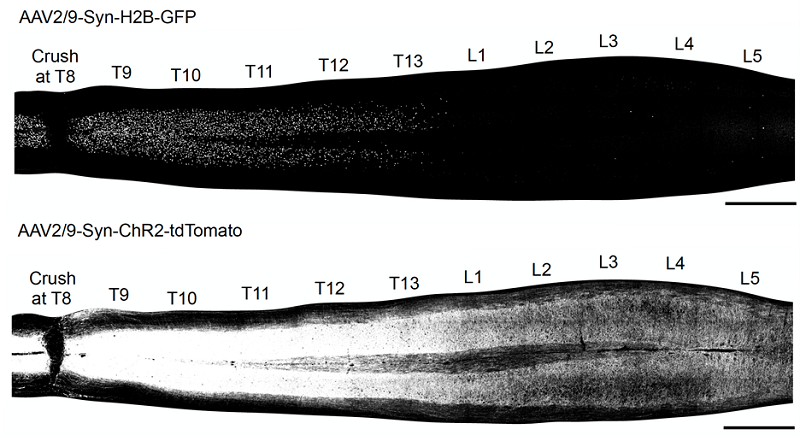By Miao He, Jessica Page, and Zhigang He
Neural circuits entirely within the spinal cord can control key aspects of locomotion. Even when there is a severe spinal cord injury (SCI) and the connections with the brain are totally broken, these internal circuits, or propriospinal network, may be structurally intact – so why not somehow take advantage of this remaining intraspinal circuitry to help people with SCI? A major technical challenge is how to efficiently target these widely distributed propriospinal neurons.
In this study, we developed a non-invasive approach to selectively target propriospinal neurons in the vicinity of an injured spinal cord. Specifically, we intravenously injected adeno-associated virus (AAV) vectors soon after spinal cord injury, where a compromised blood-brain barrier facilitates viral entrance into spinal neuronal tissue. This strategy enables targeted expression of chemogenetic actuators, the engineered proteins which are activated by an inert drug-like ligand, in propriospinal neurons and the assessment of associated behavioral outcomes.

Spinal cord images showing the cell bodies (top) and cell bodies and their axons (bottom) of propriospinal neurons
Our expanded analysis showed that precise activation of propriospinal neurons did indeed improve locomotor function in paralyzed mice after SCI. Furthermore, these neurons exhibited different functional partialities, where excitatory or inhibitory propriospinal neurons preferentially influenced two key aspects of locomotion: standing or stepping, respectively. Thus, in addition to establishing a new methodology for cell-specific targeting around a lesion site, these results demonstrate the feasibility of manipulating propriospinal neurons for functional restoration after SCI.
Miao He is a research fellow working with Zhigang He in the F.M. Kirby Neurobiology Department.
Jessica Page is a research fellow working with Zhigang He in the F.M. Kirby Neurobiology Department and a recipient of NIH F32 support.
Zhigang He is Professor of Neurology and Ophthalmology at Harvard Medical School.
Learn more in the original research paper:
Improving hindlimb locomotor function by Non-invasive AAV-mediated manipulations of propriospinal neurons in mice with complete spinal cord injury. Brommer B, He M, Zhang Z, Yang Z, Page JC, Su J, Zhang Y, Zhu J, Gouy E, Tang J, Williams P, Dai W, Wang Q, Solinsky R, Chen B, He Z. Nat Commun. 2021 Feb 3;12(1):781. doi: 10.1038/s41467-021-20980-4. PMID: 33536416; PMCID: PMC7859413.
News Types: Community Stories
